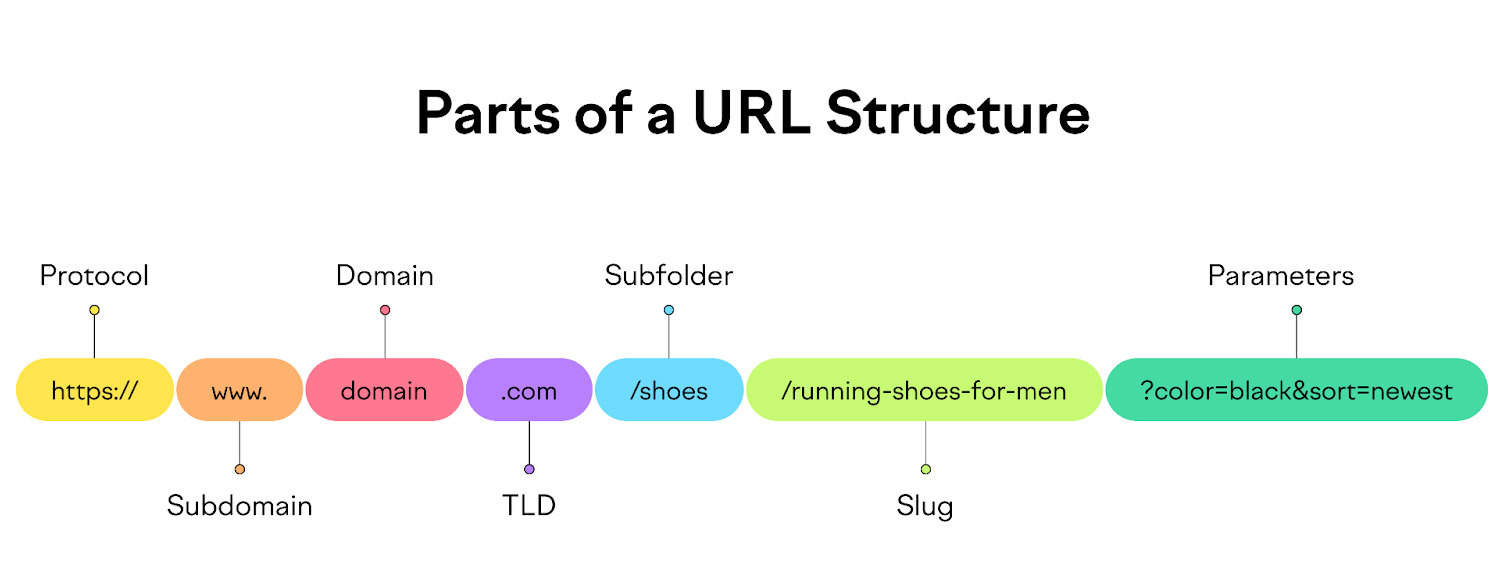URL (Uniform Resource Locator) is a web address that specifies a location on the web.
For people, it's just a link to navigate to a particular location, but a well-structured link is helpful in various ways. That is the reason it is one of the crucial elements for Google.
Before that, let's understand the Structure of the URL
What is URL Structure?
A URL is a combination of the following elements:
- Protocol – The protocol refers to the manner in which the internet browser obtains access to the data contained within a webpage. Typically, this is indicated by the prefix of either "http://" or "https://".
- Root Domain – This is the primary designation exclusive to your website.
- Subdomain– A subdomain serves the purpose of segregating a specific portion of your website from the main domain, with the intention of better organizing your content. The widely utilized subdomain is typically referred to as "www".
- TLD– It can be .com, .net, .org etc. The top-level domain (TLD) is the extension that comes after the root domain. Examples of TLDs include .com, .net, and .org.
- Slug – This is the classification in which you assign a specific webpage.
- Article Permalink– After the slug, the permalink indicates the subject matter of the webpage.

Why does URL Structure matter for SEO?
Let's illustrate this concept with an example. Suppose you're in the market for a new mobile phone, and you've asked your friend to recommend one.
Your friend visits Amazon and sends you several mobile phone links via email. The initial list of links appears as follows:
https://amazon.com/?category=456&product=46
https://amazon.com/?category=456&product=89
https://amazon.com/?category=456&product=856
Upon visiting each of these links, you discover that the first link leads to the iPhone 14s, the second link corresponds to a Samsung device, and the third link is for a Nexus mobile.
You decide that you want to purchase the Nexus phone, but you realize you've left your credit card at home. As a result, you plan to make the purchase once you return home.
Later, when you're at home, you check your email. Can you easily determine which of the three links was for the Nexus mobile?
The answer is NO.
So, to identify the Nexus mobile's link, you'll need to revisit all the links, correct?
Now, what if the links were structured like this:
https://amazon.com/mobile/iphone/14s
https://amazon.com/mobile/samsung/m30s
https://amazon.com/mobile/nexus/v1
With these properly formatted links, it becomes much simpler, doesn't it? Each URL is now human-readable and makes perfect sense.
This example demonstrates the importance of formatting URLs correctly for ease of understanding and navigation.
Here are
Best practices for SEO friendly URLs
1. Use Keywords
Include relevant keywords in your URL that reflect the content of the page. This helps search engines understand what the page is about. Keep it concise and to the point.
Suppose you have a webpage about "healthy vegetarian recipes." Instead of a generic URL like:
Non-SEO Friendly: https://example.com/page123
You should include keywords for clarity:
SEO Friendly: https://example.com/healthy-vegetarian-recipes
2. Keep It Short and Descriptive
Shorter URLs are easier to read and share. Aim for URLs that are around 3-5 words long, excluding the domain.
For a blog post about "10 Tips for Marathon Training," avoid lengthy URLs:
Non-SEO Friendly: https://example.com/blog/marathon-training-tips-for-beginners
Instead, make it concise:
SEO Friendly: https://example.com/blog/marathon-training-tips
3. Use Hyphens
Use hyphens (-) to separate words in the URL. Avoid underscores (_) or other special characters, as they can be less user-friendly.
Let's say you have a product category for "best smartwatches under $200." Use hyphens between words:
Non-SEO Friendly: https://example.com/products/best_smartwatches_under_200
SEO Friendly: https://example.com/products/best-smartwatches-under-200
4. Lowercase Letters
URLs are case-sensitive, but it's best to use lowercase letters to avoid confusion. Search engines can sometimes treat uppercase and lowercase characters differently.
Keep URLs in lowercase for consistency:
Non-SEO Friendly: https://example.com/Best-Smartwatches
SEO Friendly: https://example.com/best-smartwatches
5. Avoid Stop Words
Remove unnecessary stop words (e.g., "and," "the," "of") from your URLs to make them cleaner and more concise. They don't add value to your SEO.
For a page about "The Importance of SEO in Digital Marketing," remove stop words:
Non-SEO Friendly: https://example.com/importance-of-seo-in-digital-marketing
SEO Friendly: https://example.com/seo-importance-digital-marketing
6. Static URLs
Use static, permanent URLs that don't change over time. Avoid using dynamic URLs with query strings, which can be confusing for search engines and users.
Use static URLs that don't change over time, even if you update the content. If you initially create a URL like:
Non-SEO Friendly: https://example.com/blog/post?id=123
Use a static version:
SEO Friendly: https://example.com/blog/seo-best-practices
Importance of URL structure in SEO
The URL structure is an essential component of SEO (Search Engine Optimization) for several reasons. A well-structured URL can have a significant impact on your website's search engine rankings and overall user experience. Here's why URL structure is important in SEO:
a) Crawling and Indexing
Search engine bots use URLs to discover and index web pages. A clear, logical, and organized URL structure makes it easier for search engines to crawl and understand the content of your site. This, in turn, can lead to better visibility in search results.
b) Keyword Relevance
Including relevant keywords in your URL helps search engines and users understand what a page is about. When keywords are in the URL, it can contribute to improved ranking for those specific terms.
c) User Experience
A well-structured URL is not just about SEO; it's about providing a better user experience. Users can look at the URL and gain insights into the content of the page before clicking on it. Clear, descriptive URLs can increase the click-through rate.
d) Readability and Accessibility
URLs should be human-readable, meaning they should make sense to users. Clear URLs are accessible to people with disabilities and assistive technologies. This is not only good for SEO but also for web accessibility.
e) Link Sharing and Anchor Text
When users share links to your content, the URL often becomes the anchor text for those links. An informative and concise URL can encourage others to link to your content. The anchor text in these backlinks can further boost your SEO.
f) Duplicate Content Avoidance
Proper URL structure can help prevent duplicate content issues. Search engines may penalize websites that have identical or very similar content accessible through different URLs. A clear structure can minimize this risk.
g) Site Organization
A logical URL structure reflects how your website is organized. This makes it easier for both search engines and users to navigate your site. An organized structure helps users find what they're looking for and can improve the user experience.
h) Ranking Factors
While the URL structure is just one of many SEO factors, it is still a part of the overall ranking algorithm used by search engines. When combined with other SEO best practices, a well-structured URL can contribute to higher rankings.
i) Future Scalability
An effective URL structure is flexible and scalable. As you add more content and pages to your website, a well-thought-out structure makes it easier to maintain and grow without creating confusion.
Conclusion
In summary, a well-structured URL is a fundamental aspect of SEO that contributes to better search engine rankings, user experience, and overall website organization. It's a relatively simple yet effective way to enhance your website's performance in search results and improve user engagement.


